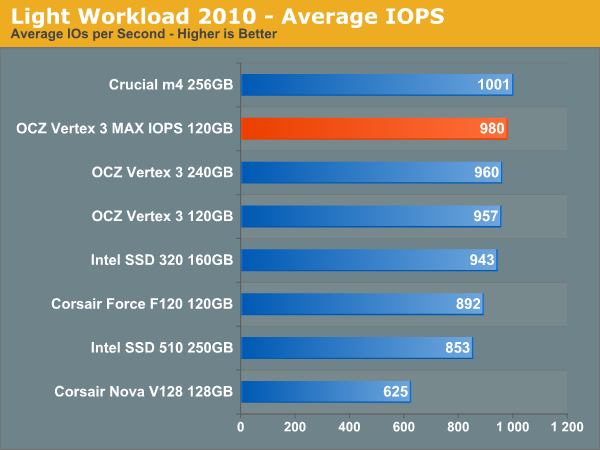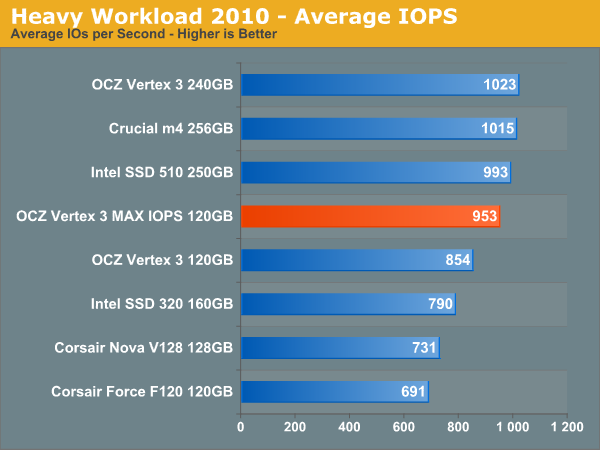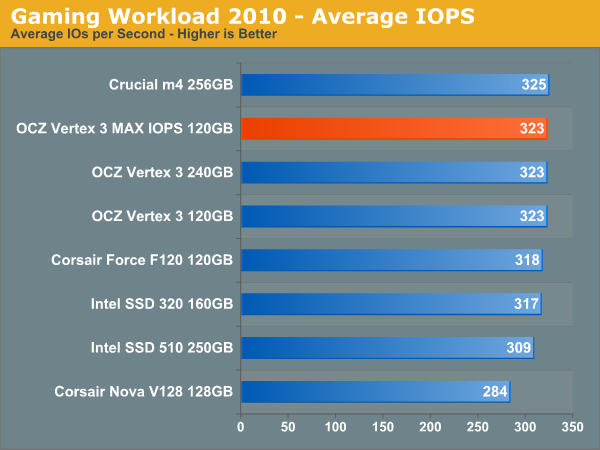OCZ Vertex 3 MAX IOPS & Patriot Wildfire SSDs Reviewed
by Anand Lal Shimpi on June 23, 2011 4:35 AM ESTAnandTech Storage Bench 2010
To keep things consistent we've also included our older Storage Bench. Note that the old storage test system doesn't have a SATA 6Gbps controller, so we only have one result for the 6Gbps drives.
The first in our benchmark suite is a light/typical usage case. The Windows 7 system is loaded with Firefox, Office 2007 and Adobe Reader among other applications. With Firefox we browse web pages like Facebook, AnandTech, Digg and other sites. Outlook is also running and we use it to check emails, create and send a message with a PDF attachment. Adobe Reader is used to view some PDFs. Excel 2007 is used to create a spreadsheet, graphs and save the document. The same goes for Word 2007. We open and step through a presentation in PowerPoint 2007 received as an email attachment before saving it to the desktop. Finally we watch a bit of a Firefly episode in Windows Media Player 11.
There’s some level of multitasking going on here but it’s not unreasonable by any means. Generally the application tasks proceed linearly, with the exception of things like web browsing which may happen in between one of the other tasks.
The recording is played back on all of our drives here today. Remember that we’re isolating disk performance, all we’re doing is playing back every single disk access that happened in that ~5 minute period of usage. The light workload is composed of 37,501 reads and 20,268 writes. Over 30% of the IOs are 4KB, 11% are 16KB, 22% are 32KB and approximately 13% are 64KB in size. Less than 30% of the operations are absolutely sequential in nature. Average queue depth is 6.09 IOs.
The performance results are reported in average I/O Operations per Second (IOPS):

If there’s a light usage case there’s bound to be a heavy one. In this test we have Microsoft Security Essentials running in the background with real time virus scanning enabled. We also perform a quick scan in the middle of the test. Firefox, Outlook, Excel, Word and Powerpoint are all used the same as they were in the light test. We add Photoshop CS4 to the mix, opening a bunch of 12MP images, editing them, then saving them as highly compressed JPGs for web publishing. Windows 7’s picture viewer is used to view a bunch of pictures on the hard drive. We use 7-zip to create and extract .7z archives. Downloading is also prominently featured in our heavy test; we download large files from the Internet during portions of the benchmark, as well as use uTorrent to grab a couple of torrents. Some of the applications in use are installed during the benchmark, Windows updates are also installed. Towards the end of the test we launch World of Warcraft, play for a few minutes, then delete the folder. This test also takes into account all of the disk accesses that happen while the OS is booting.
The benchmark is 22 minutes long and it consists of 128,895 read operations and 72,411 write operations. Roughly 44% of all IOs were sequential. Approximately 30% of all accesses were 4KB in size, 12% were 16KB in size, 14% were 32KB and 20% were 64KB. Average queue depth was 3.59.

The gaming workload is made up of 75,206 read operations and only 4,592 write operations. Only 20% of the accesses are 4KB in size, nearly 40% are 64KB and 20% are 32KB. A whopping 69% of the IOs are sequential, meaning this is predominantly a sequential read benchmark. The average queue depth is 7.76 IOs.











112 Comments
View All Comments
lyeoh - Thursday, June 23, 2011 - link
Because the main reasons why so very many SSD drives fail does not appear to be due to the "nm" of the NANDs.As far as I know, the larger "nm" SSDs also have been failing a lot.
Movieman420 - Thursday, June 23, 2011 - link
Can't wait until you guys get your hands on the hard to find/unavailable 240gb MaxIOP drive. It will obviously be the king once it hits the channel. Farther down the road, I dare say that the MaxIOP will be bested. How? you ask? The answer...the soon to be available Samsung 27nm DDR toggle nand said to out run the 32nm SDR toggle by 40-60 percent as well as match the durability (p/e cycles) of 34nm nand! Now the big question is...Does the SF2281 have enuff uuumph left to utilize the much faster DDR nand? I'm hoping that the lower cost of the 27nm process nand will offset the 'fastest nand' price premium that will surely be levied. Also, the new 27nm DDR will be available in both 32Gb and 64Gb dies which will allow there to be a higher performance 60GB SF2281 drive...atm the only Ocz 60gb SF2281s are the Agility 3 and Solid 3 which are almost beaten by the Vertex 2 34nm equivalent...that's why they didn't earn the Vertex 3 name tag. A higher performing small drive is just the thing that raid fanatics like me like to use. You can have a fast array without spending $300-$500 per drive for real sata III performance. This is why a 60gb Vertex 3 drive would sell like wild fire. Don't get me wrong, my current 4 x 34nm Vertex 2 60gb array is plenty fast but don't have near the compressed write resilience (aka less nand throttling) of the SF2281 drives. I look forward to spending ~$300 for 2 V3 60's that will totally blow away a single $300 120gb/$500 240gb V3.L. - Thursday, June 23, 2011 - link
I don't quite get what you are trying to say.But basically, DDR = RAID0 2 elements .
So between 8 dies on an 8 channel controller and 8 ddr dies on a 4 channel controller you should see absolutely no difference.
Now considering current controllers have 8+ channels and the smallest ddr at the expected time of implementation is a dual die 32gb nand chip .. that's 240GB and abbove.
This is not the world of RAM where you can just stick more chips in parallel (ddr5...), then dual channel controller over that etc.
Of course the same ideas are always applicable, but for those samsung ddr chips to be worth anything you'd need to go to 480GB+ and no they're not faster than anything they're just ddr, and that difference matters a lot.
You will not find two 60GB drives that are better in raid0 than a single 120GB drive, because said 120GB drive is basically those two drives in raid0, with one less controller and the raid on the sandforce controller, better algorithm usage etc.
Again, number of channels, nand packages, etc.
Unless somebody starts making 32 GB DDR5 NAND dies I don't expect much change in there ;)
Gittun - Thursday, June 23, 2011 - link
You do realize the 240GB max iops edition is already in the graphs?The_True - Thursday, June 23, 2011 - link
Well!!i wont say anything bad about anand, but i think anad is putting his hand on fire for OCZ SSD.
i used to like OCZ, but i get tired of RMA and windows Reinstall every other week.
i dont care about 20 or 30 MB/S faster, i care about relaibility, not benchmark the driver every hour to make me feel good.
OCZ driver are not reliable, if you use your computer for work, go Intel is the only SSD out there that is reliable for business.
MAX IOPS?? i called it MAX windows re install!!
after getting two intel 510 250Gb, i been running windows without problems for two months, now i can work without worry.
velis - Thursday, June 23, 2011 - link
I'd hardly call "I have 8 of these and haven't seen the problem so I tend to believe OCZ" putting one's hand into fire. He's just stating his observations.And just so you know:
I started out with OCZ Core 120GB SSD (1st gen crap). Had to replace two of them before support finally figured out that my usage patterns burn out *every* Core SSD in about two months. And I most certainly don't blame OCZ - it was me who was uneducated and bought the wrong disk back then.
So they gave me a Vertex 1 120GB (Indilinx) as a replacement. Been happy with it ever since (sept. 1009).
Additionally I bought 3 Intel X25 80GB G2s. Each and every one of them has given me pain. Not lots of it, but it has. Every once in a while I get a corrupt sector or two, checkdisk runs on it and then I'm fine for the next few weeks. My main computer now needs reinstall because these once-in-a-while events brought the disk (in one year time) into such a state that I had to disable monitor sleep because otherwise the computer won't wake up after it any more. Not to mention other various BSODs and stuff. Luckily I keep my important data on spinning disks and back up to 3 different destinations. Any yes, I know I'm lazy :P
On the other hand, the Vertex never gave me any reason not to like it. In fact - I use it in my work computer and brag about it to all the rest of the company I work for. Luckily for me my bosses don't want to invest into SSDs yet so currently I have the fastest "server" around :D
So, as far as I'm concerned, it's intel who is unreliable, not OCZ...
Jaybus - Friday, June 24, 2011 - link
Why would you say that about the hand in the fire? On almost every one of these reviews, he says something like the following quote from this article.</p><p>"I still believe the Intel SSD 510 is a great balance of performance and reliability. If you want something with an even lower failure rate, there's always the Intel SSD 320 "
Minion4Hire - Thursday, June 23, 2011 - link
I've had a very similar experience to Anand's. Between my own and my immediate family's computer's I am running 2 Intel drives (G2 and 320), 3 OCZ (Agility, Vertex, Agility 2) and Corsair (Force) and have not had the slightest issues with any of them. Of the various computers I have built for other people I have only recently seen a single SSD die, which was an Indilinx Agility from 1.5 years ago. Replaced it with a Vertex 2.People are going to have issues but I, like Anand, don't bother trying to optimize or tweak anything. AHCI enabled, all other drive, BIOS, and OS settings are on their defaults. Everything I've used has worked flawlessly. I'm not saying some people haven't had problems, but is this anger really any different than any other brand rage?
Sandforce is arguably the most popular controller manufacturer atm. Frankly, one of very few options. Obviously some people are going to have problems. And those people are going to be able to find other people who ALSO have those problems. It doesn't mean everyone is having them.....
michal1980 - Thursday, June 23, 2011 - link
Anand is carring water for OCZ.A mystery fat envelop of cash showed up in someones mail box?
So OCZ claims they have a ~1% failure rate, and you just belive them? what manufacture wont lie about that?
P.S. your sample size of 1 or 2, is not good enough to make any claims as to the quality of the product.
The_True - Thursday, June 23, 2011 - link
have you notice that in Anandtech are more Review about OCZ than any other site on the net?lol.... "A mystery fat envelop of cash showed up in someones mail box?
" hahahahah...lol
i mean what is going on Anand??